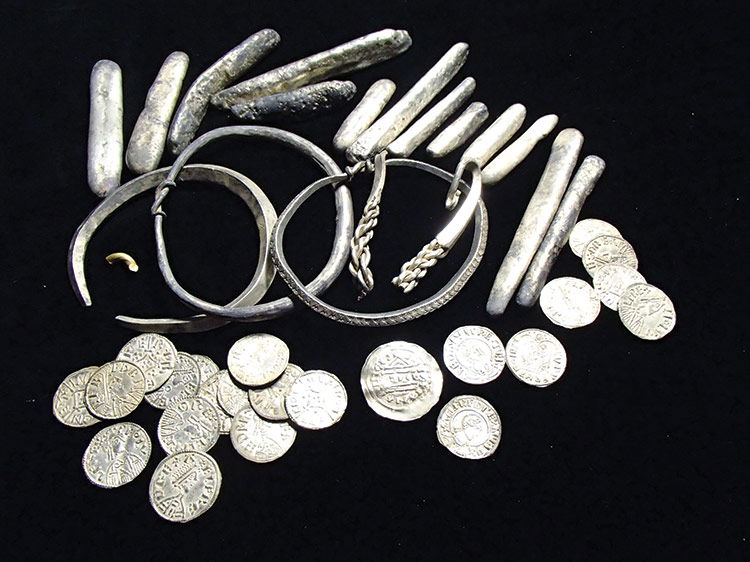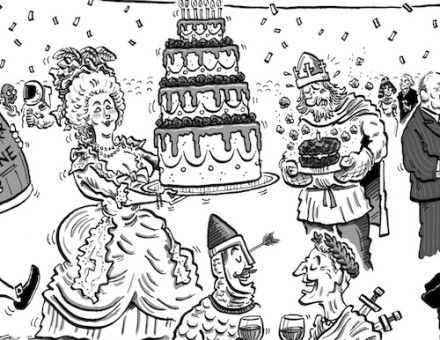Evidence of an Anglo-Saxon Alliance
A newly found hoard offers insights into an England threatened by Vikings.
 The Watlington hoard, found in Oxfordshire in 2015, is a gift to the historian. It dates from the 870s: a decade which saw Alfred the Great face and, after some near misses, stave off a Viking invasion of Wessex. These years also witnessed the rule of Ceolwulf II, the last self-styled king of the Mercians, a powerful people originally based in the West Midlands, who had been the major force between the Thames and the Humber for two centuries. Most of the narrative built around these two figures comes from the Anglo-Saxon Chronicle, which focuses on an account of Alfred’s war with the Vikings, as might be expected from a text put together by scholars in Wessex in the decades after the ultimate West-Saxon victory. But the Chronicle’s coherence and focus comes at the expense of breadth and it skates around some of the messier realities. Ceolwulf II, in particular, receives rough treatment. Appointed by the Vikings in 874 and losing half his territory to the invaders in 877, the Chronicle writes him off as a ‘foolish king’s thegn’.
The Watlington hoard, found in Oxfordshire in 2015, is a gift to the historian. It dates from the 870s: a decade which saw Alfred the Great face and, after some near misses, stave off a Viking invasion of Wessex. These years also witnessed the rule of Ceolwulf II, the last self-styled king of the Mercians, a powerful people originally based in the West Midlands, who had been the major force between the Thames and the Humber for two centuries. Most of the narrative built around these two figures comes from the Anglo-Saxon Chronicle, which focuses on an account of Alfred’s war with the Vikings, as might be expected from a text put together by scholars in Wessex in the decades after the ultimate West-Saxon victory. But the Chronicle’s coherence and focus comes at the expense of breadth and it skates around some of the messier realities. Ceolwulf II, in particular, receives rough treatment. Appointed by the Vikings in 874 and losing half his territory to the invaders in 877, the Chronicle writes him off as a ‘foolish king’s thegn’.
The coins from Watlington provide an important new perspective on the situation as it developed during these crucial years. Ceolwulf II functioned as fully as any king, issuing charters and coins, including many in the new hoard, which is a time capsule from the late 870s, containing silver pennies produced at locations across southern England, in the names of both West-Saxon and Mercian rulers. However, it was probably put together by one of the Viking raiders. Silver ingots and other silver objects, as well as a piece of gold bullion, were found in the hoard and the coins include specimens from continental Europe: features characteristic of precious metal collections gathered and concealed by Vikings, rather than the English. Watlington is a long way from areas settled by the Vikings, so the hoard may represent the accumulated wealth of a member of the Viking army, buried towards the end of its ultimately unsuccessful campaign in Wessex.
While the hoard’s assembly and concealment are a matter of conjecture, the evidence it presents for the coinage of the 870s offers firmer ground. The hoard contains silver pennies (over 180 in total) of Alfred and Ceolwulf II. All seem to date to about the mid-870s and after. This was a period of rapid evolution for the coinage of Mercia and Wessex. The two kingdoms had shared a currency since Wessex, under Alfred’s brother and predecessor Æthelred I (865-71), adopted the established Mercian ‘Lunettes’ design in the mid-860s. This move is symptomatic of the political status quo at the time: Wessex and Mercia were rivals and allies rather than adversaries. Æthelred I may have wanted to benefit from the tendency for Mercian ‘Lunettes’ pennies to contain less silver, which made it difficult for West-Saxon coins to circulate competitively alongside them. By the time Burgred, king of the Mercians (r.854-74), was forced into exile by the Vikings, this process of debasement had reached a low point. But the monetary entente cordiale between Mercia and Wessex still held. Alfred and Ceolwulf II, Burgred’s successor, undertook to restore the quality of the coinage.
Several new designs were tried out. Most specimens (including the bulk of the hoard) belong to a group known to scholars as the ‘Cross and Lozenge’ type. This featured an elaborate cross enclosed within a lozenge on the reverse, paired with a handsome bust of the king, inspired by Roman coins.
Among the most interesting of the other designs was one which again placed a bust on the obverse, but with a different reverse, which showed two emperors enthroned side by side. The ninth-century Anglo-Saxon manufacturers drew this from Roman coins of the fourth and fifth centuries, issued when emperors shared power. In the context of the rapprochement between Mercia and Wessex, it is unlikely that this image was without resonance; the two emperors might have evoked the co-operation between Alfred and Ceolwulf II. Until the discovery of the Watlington hoard, just two specimens of this coinage had been found, one each for Alfred and Ceolwulf II. It had seemed possible that this coinage might even have been some sort of limited edition; a rarity for the Anglo-Saxons. But Watlington has added over a dozen more specimens, by a number of new moneyers and diverse in style; an indication that, although this may have been a short-lived coinage, it was produced on a significant scale. The coinage with the two emperors stands out as a substantive as well as symbolic segment of the coinage of the 870s.
One central question historians and numismatists will consider is what kind of infrastructure lies behind the coinage. Most pennies from the ninth century carry the name of the man who made the coin, the moneyer, as well as that of the king under whom he worked. It is rare for coins of this period, however, to carry an explicit reference to where they were made. Canterbury and London were both mint-towns, but which coins belong to each and which might be the work of moneyers based elsewhere? Did moneyers move between different places, or did kings share the services of moneyers in major centres such as London? The coins in the Watlington hoard may give fresh answers to these questions and the nuts and bolts of the monetary system which emerge could speak volumes about the organisation and economic geography of ninth-century England.
A larger issue which will have to be revisited is the relationship between money and politics. Who chose to use images such as the two emperors: one or both kings, or local authorities such as the moneyers? Who chose how to title the kings on their coins? Alfred, for instance, was referred to as rex Anglo[rum] ‘king of the Angles/English’ on some of the ‘Two Emperors’ pennies, and as rex S[axonum et] M[erciorum], ‘king of the Saxons and the Mercians’, on others: both are highly loaded titles, making statements about the status of the two kingdoms.
The Watlington hoard offers an increasingly clear window onto the interaction of Mercia, Wessex and the Vikings, as well as the local articulation of political and economic power. One can only look forward to what else will be seen by gazing through it.
Rory Naismith is Lecturer in Medieval History at King's College London. @Rory_Naismith




